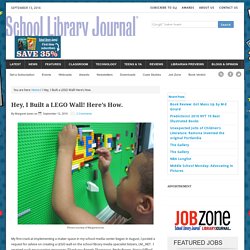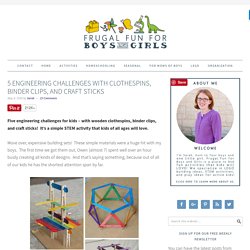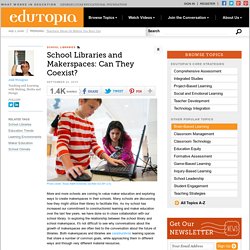

Hey, I Built a LEGO Wall! Here’s How. Photos courtesy of Margaret Jones My first crack at implementing a maker space in my school media center began in August.

I posted a request for advice on creating a LEGO wall on the school library media specialist listserv, LM__NET. I received such encouraging responses (Thank you Pamela Thompson, Becky Brown, Nancy Gifford, Jennifer Chance Cook, Peg Noctor, and others!) , that I decided to embrace Nike’s “Just Do It” slogan and give it a try. Here’s my “recipe” for creating the wall. What you’ll need • A wall, or other vertical surface to build on • LEGO base plates. . • Fuze It or other adhesive • Caulk gun • Duct tape • LEGO (of course!) Building the wall Starting out, I took the advice of fellow LM_NET members and hosted a week-long LEGO drive. On Monday, the first day of school, every child went home with a flyer (in English, Spanish, and Portuguese) asking for donations of used LEGOs, and a “Parental Consent to Donate” form.
Next, I shopped for the green 32″ x 32″ studded base plates. 5 Engineering Challenges with Clothespins, Binder Clips, and Craft Sticks. Five engineering challenges for kids – with wooden clothespins, binder clips, and craft sticks!

It’s a simple STEM activity that kids of all ages will love. Move over, expensive building sets! Engineering Project for Kids: Build a Straw Roller Coaster! 27 Makerspace Materials & Supplies - Makerspaces.com. Beginner Electronics Project: The TapeTricity Card. A TapeTricity solar system.

Check out all those ringed planets! The train has left the station! A motivational frog with glowing red eyes. 7 tips for creating a learner-centered makerspace. FAQs about Makerspaces. What is needed to start a Makerspace in a classroom or school?

Passion - You need to have passion and a belief in the educational value of maker-style projects. Space - This can be a whole room or only part of a room. Supplies - Start small with simple craft materials. Often sending a message out to colleagues and the community asking for donations of materials works well. Storage - Create a place to store materials when they are not in use and student projects as they are being worked on. Where should the Makerspace be placed? 27 Makerspace Materials & Supplies - Makerspaces.com. 27 Makerspace Materials & Supplies - Makerspaces.com. School Libraries and Makerspaces: Can They Coexist? More and more schools are coming to value maker education and exploring ways to create makerspaces in their schools.

Many schools are discussing how they might utilize their library to facilitate this. As my school has increased our commitment to constructionist learning and maker education over the last few years, we have done so in close collaboration with our school library. In exploring the relationship between the school library and school makerspace, it's not difficult to see why conversations about the growth of makerspaces are often tied to the conversation about the future of libraries. Both makerspaces and libraries are constructivist learning spaces that share a number of common goals, while approaching them in different ways and through very different material resources. Similar Yet Distinct Makerspaces and libraries are sites of informal learning.
A Thematic Approach to Planning Your Maker Space. When schools talk about the Maker Movement and creating maker spaces, they often focus their initial thinking on purchasing the tools and materials.

This resource-driven approach can create a buzz in your school for some time; however, that excitement will inevitably fade. While resources are an important part of any maker space, taking a thematic planning approach is much more effective. No two maker spaces are alike or should be alike. A Librarian’s Guide to OER in the Maker Space. Dynamic, living, breathing, current, personalized, adaptive, engaging, creative, cutting-edge, and current are just some of the words that have been used to describe the open educational resources (OER) movement.

The U.S. Department of Education recently expanded its efforts to increase schools’ access to high-quality, openly licensed learning resources, giving educators more access to technology to personalize learning for their students. Starting a School Makerspace from Scratch. Curiosity Machine. Our Makerspace Journey. The Stewart Middle Magnet School Library Makerspace Journey I first started my makerspace journey at Stewart Middle Magnet School in January 2014 with a few bins of K’nex spread out on some library tables.

Tinkering Fundamentals: A Constructionist Approach to STEM Learning - Exploratorium. About the Course The Tinkering Fundamentals course will offer educators and enthusiasts an opportunity to develop a practice of tinkering and making.

We see tinkering as a serious endeavor--one that is generalizable across content and especially good at interweaving disciplines in a way that leads to complex projects and individualized learning opportunities. Tinkering has recently been introduced into the educational field as a potential driver of creativity, excitement, and innovation in science learning. It is seen by many as an effective means to engage in exploring STEM concepts, practices and phenomena. For over a decade, the Exploratorium has been developing science-rich tinkering activities. Tinkering typically blends the high- and low-tech tools of science along with a strong aesthetic dimension that supports self-expression among children as well as adults.
NOTE: This is a hands-on workshop, so you will need to obtain or purchase course materials as soon as possible. 1. 2.